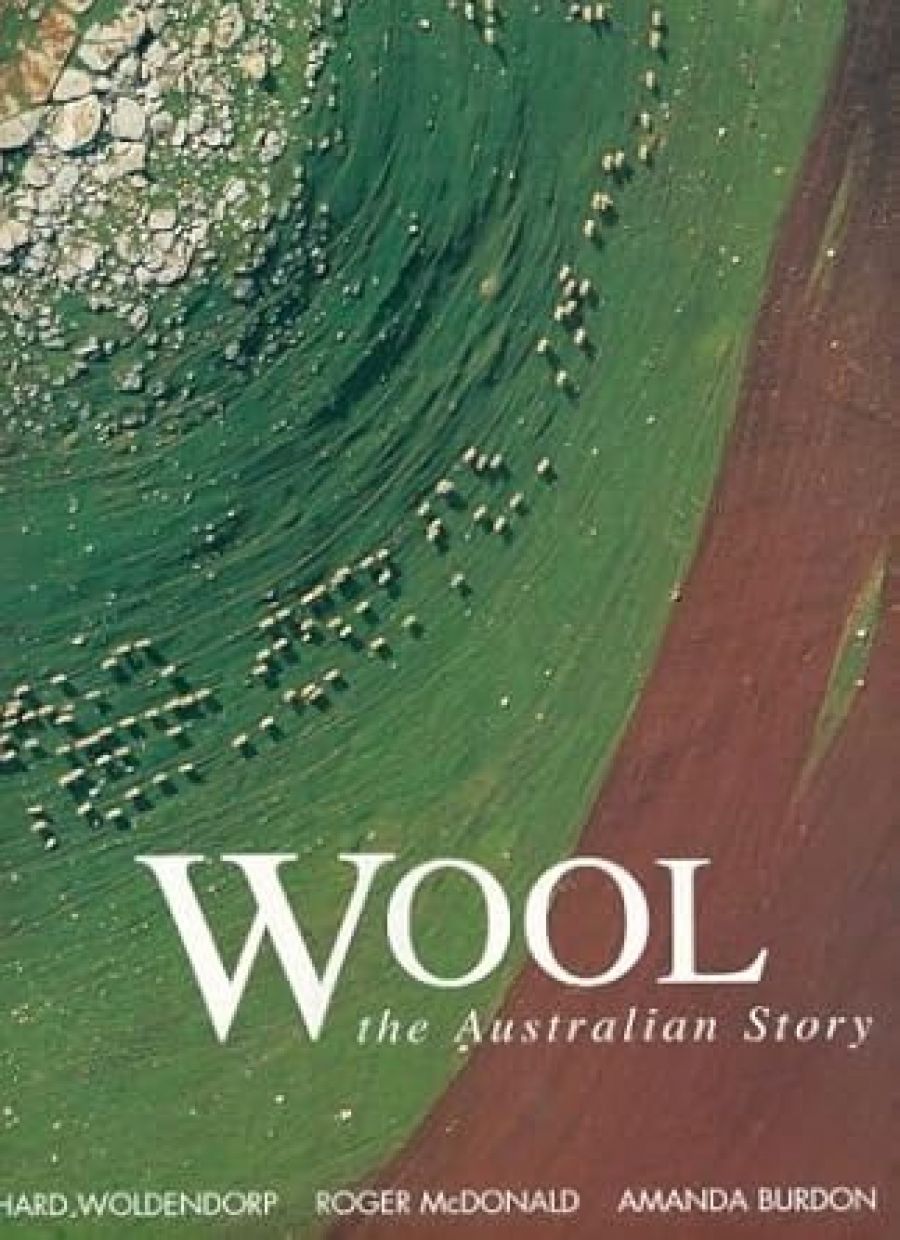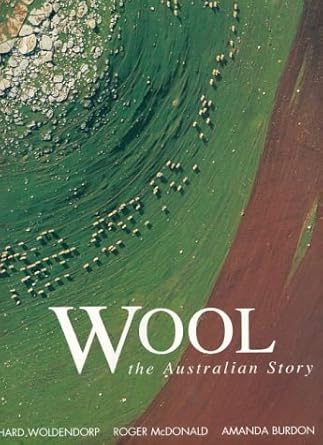
- Free Article: No
- Contents Category: Fashion
- Review Article: Yes
- Article Title: Hard Hooves on an Old Soil
- Online Only: No
- Custom Highlight Text:
The extraordinary photographer Richard Woldendorp joins writers Roger McDonald and Amanda Burdon in Wool, a sumptuous presentation that celebrates with every glossy page. But is Wool a celebration or a wake? Why publish such a book in 2003? Who is it for?
- Book 1 Title: Wool
- Book 1 Subtitle: The Australian Story
- Book 1 Biblio: Fremantle Press, $59.95 hb, 232pp
- Book 1 Cover Small (400 x 600):

- Book 1 Cover (800 x 1200):

McDonald’s introduction offers a short, bland, sheep-centred history of Australia. Rich with generalisations, this section names no sources (except for the sole direct quotation – E.W. Lander’s diary of eating a sheep over seven days in 1847). It lacks, too, the gritty human stories of McDonald’s earlier and better The Shearer’s Motel. Elegant with its illustrative historical photographs, the introduction evokes the high school geography books of my youth in the early 1970s. Such books taught young citizens to take pride in the way that Australia lived ‘off the sheep’s back’, even as our economy ran on minerals while wool was stockpiled. I was relieved when McDonald’s narrative stopped abruptly at the end of the nineteenth century, leaving out most of the long years that bred distinctive characteristics into Australian sheep.
Once in the twentieth century, Woldendorp’s photographs take the lead in a narrative complemented by captions and short chapters by Burdon. Their geographic span is impressive, drawing the nation together with woollen threads from the Pilbara to the Tasmanian midlands. Periodically, a textbook-style ‘box’ on a tangential issue spreads across a double page: dogs, fences, cooks and New Zealanders feature. Boxes are good for photographs, but interrupt narrative momentum.
Perhaps this doesn’t matter. The book is going nowhere anyway. It meanders through the people and places of wool, celebrating the product and its society. Heritage is a theme running through stately homes, crumbling (or working) shearing sheds, outback race meetings, agricultural shows, museums and ubiquitous monuments commemorating the industry. The industry is allegedly at a ‘crossroads’, yet its problems (apart from wool prices) remain implicit, unexplored. Its future is mysterious.
The ‘Portrait Gallery’ sends mixed messages. Whether they are hugging prize rams or standing on their estates, wool growers generally have older faces. Almost all of them were born into wool farming. There are younger faces among the managers, rouseabouts and shearers, but Woldendorp has reserved most individual portraits for the industry’s elders. Glorious action shots of shearing or smokos reinforce a political stereotype of shearers in collective action, in stark contrast to fiercely individualistic growers. There are some women, but not many. It is among the shearers that we find this book’s Aboriginal people, who are significantly missing from the frontier history, despite the fact that sheep, those ‘foot soldiers of empire’, displaced so many indigenous Australians.
Sheep and environmental damage are seldom mentioned in the same sentence. One organic wool grower consciously tries to put minerals back into the soil via the sheep themselves, not chemical additives. But silence prevails on soil poverty, dust storms and the compaction caused by a hard hoof on an old soil, Australia’s particular environmental legacy. Erosion and feral weeds (Salvation Jane) are featured in two landscape photographs, but the majority of landscapes, however damaged, are featured in their best possible light. One striking aerial image of sheep dotting a faintly green paddock in Tasmania carries the caption ‘like maggots crawling on the skin of the earth’. It is a rare negative comment in an overwhelmingly celebratory volume.
Cooma pastoralist Charles Massy, who provides a preface and the first of the portraits for Wool, captures the tone of the book in his lament: ‘We have to produce superior performing fibres for our customers at an efficient cost with environmental sustainability superimposed on top’ (my emphasis). The industry’s future surely requires environmental sustainability to be a first, rather than a last, consideration? Sustainability is portrayed here as a burden imposed by outsiders on battling growers, who work in the interests of the nation’s economy and identity. Our woolly identity may be easier to fix than the environmental unsustainability.
Wool is tempered with a sadness that the wool industry is not what it once was. Many of the people interviewed have moved away from sheep to other animals. In the west, feral goats pay better. But they are hardly going to improve soil quality, either. There is a powerful nostalgia at play in the stud ram monuments, a hankering for the 1950s, when wool prices were at their peak and the nation took pride in its single Great Industry. Wool was the industry for a nation isolated from markets, but transport and the notion of a marketable commodity have become vastly more sophisticated since then. The environmental damage caused by sheep in marginal agricultural lands has, however, worsened.
Is the industry really in decline? Or is it just waiting? A 100 years ago, the nation saw the flock reduced from seventy-five to fifty-three million sheep in the 1901–03 droughts. Today, there are more than 123 million sheep on the mainland alone. Each animal is, on average, bigger and carrying a much heavier fleece than in 1901 on those same small, hard hooves. Wool’s significance to the nation’s wealth is in decline, but sheep continue to inflict damage, even more than before, particularly in Australia’s arid zone. Our identity politics need review, not celebration. Wool is no longer the Australian story. It is more a case of mistaken identity.


Comments powered by CComment